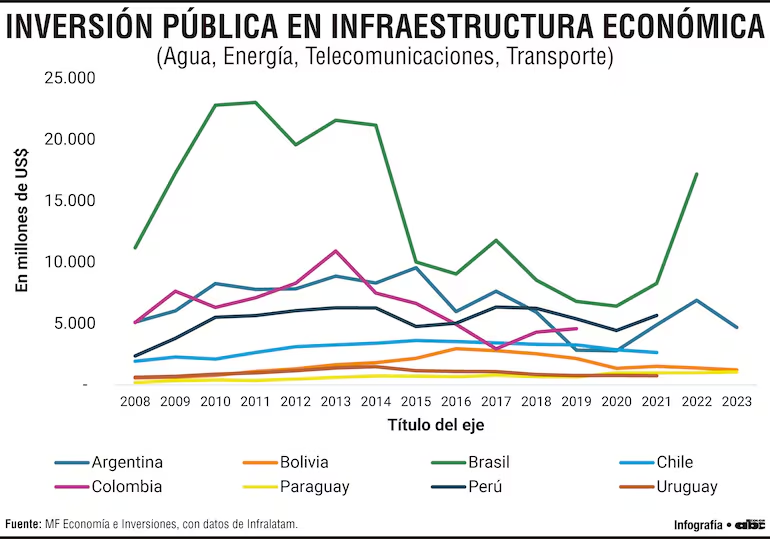When we think about Latin America’s economic growth and regional competitiveness, infrastructure investment plays a critical role. Yet, compared to other emerging economies worldwide, Latin America has often lagged behind in this key area. Despite these challenges, Paraguay is emerging as a regional leader in infrastructure investment, positioning itself as a country with strong potential for development.
How Does Paraguay Compare?
Between 2019 and 2023, public investment in economic infrastructure—covering sectors like water, energy, telecommunications, and transportation—revealed notable disparities among Latin American countries. Paraguay stands out, with investment equivalent to 2.5% of its GDP, surpassing larger economies like Argentina, Chile, and Peru. In comparison, regional giants such as Brazil and Mexico invest less than 1% of their GDP in infrastructure.
But what does this mean in absolute terms? While Paraguay may dedicate a relatively high percentage of its GDP to infrastructure, the actual investment amounts remain modest due to the smaller size of its economy. For example:
- Brazil: Over $17 billion in 2023
- Argentina: $4.6 billion
- Paraguay: $1.05 billion
Despite these differences, Paraguay is laying down an important foundation for long-term growth, focusing on transportation, energy, and telecommunications—key sectors for enhancing regional integration and economic development.
Opportunities and Challenges
Paraguay’s strategy of focusing on infrastructure investment is commendable, but it isn’t without its challenges. The country faces structural limitations in financing capacity, resulting in increased reliance on external funds and public-private partnerships (PPPs). Other obstacles include:
- Bureaucratic hurdles that delay projects
- Limited public financing and fiscal constraints
- Lack of long-term strategic planning
To overcome these issues, Paraguay must prioritize transparency in project execution, strengthen project planning, and continue fostering innovative financing models. Many Latin American countries have seen success with PPPs, and recent reforms in Paraguay aim to replicate that success.
Why This Matters for Future Growth
Infrastructure development is crucial for any country’s competitiveness. In Paraguay’s case, its potential lies in becoming a hub for regional trade and integration. With strategic investments in energy and transportation, the country could position itself as a vital logistics and energy player in the region.
For investors, this focus on infrastructure provides opportunities in several areas:
- Energy Projects: Paraguay is already known for its renewable energy potential, particularly with hydropower from the Itaipú Dam.
- Logistics and Transportation: Enhanced connectivity will improve Paraguay’s position in regional trade networks.
- Telecommunications: Digital transformation in Paraguay offers untapped opportunities for growth in this sector.
The Future Is Promising
Paraguay’s infrastructure story is just beginning. Although challenges remain, the country’s high level of public investment relative to its GDP is a sign of its commitment to modernization and development. For those seeking to invest in a growing market, Paraguay offers a unique combination of potential and opportunity in Latin America.
With the right reforms and strategic planning, Paraguay could soon become one of the most dynamic markets in the region, standing shoulder to shoulder with Latin America’s top economies.
FAQ: Paraguay’s Infrastructure Investment
1. Why is infrastructure investment crucial for Paraguay’s growth?
Infrastructure is key to boosting regional integration, improving connectivity, and enhancing the country’s competitiveness. Investments in transportation, energy, and telecommunications can help Paraguay become a major player in South American trade and logistics.
2. How does Paraguay compare with its neighbors in infrastructure spending?
Paraguay invests around 2.5% of its GDP in infrastructure, which is higher than countries like Argentina, Chile, and Peru. However, due to its smaller economy, the absolute investment amount remains modest.
3. What sectors are prioritized in Paraguay’s infrastructure development?
The main focus is on transportation, energy (especially hydropower), and telecommunications. These sectors are essential for regional integration and digital transformation.
4. What challenges does Paraguay face in its infrastructure growth?
Challenges include bureaucratic delays, limited public financing, and the need for long-term strategic planning. Paraguay increasingly relies on public-private partnerships (PPPs) to address these issues.
5. What are the opportunities for investors in Paraguay’s infrastructure?
- Energy projects: Hydropower and renewable energy offer significant potential.
- Logistics and transportation: Investments in transportation infrastructure can improve trade networks.
- Telecommunications: Digital transformation presents growth opportunities, particularly in expanding internet connectivity.
6. How does Paraguay’s renewable energy sector stand out?
Paraguay is one of the world’s largest exporters of renewable energy, mainly from the Itaipú Dam, one of the most powerful hydroelectric facilities in the world.
Interesting Facts About Paraguay’s Infrastructure
- Hydropower Giant: The Itaipú Dam supplies nearly 90% of Paraguay’s electricity, making the country a global leader in clean energy production.
- Expanding Road Network: Paraguay’s road network has doubled in length in the last decade, improving connectivity to neighboring countries like Brazil and Argentina.
- Digital Growth: The country’s focus on telecommunications is transforming its digital landscape, with internet penetration increasing rapidly in recent years.
- Public-Private Partnerships: Recent reforms in Paraguay’s PPP framework have attracted international investors, particularly in transportation and energy sectors.
- Strategic Location: Paraguay’s location in the heart of South America gives it the potential to become a logistics hub for regional trade.
- Low Debt Levels: Despite challenges, Paraguay’s public debt remains relatively low compared to other Latin American countries, offering fiscal stability for long-term projects.






Leave a Reply